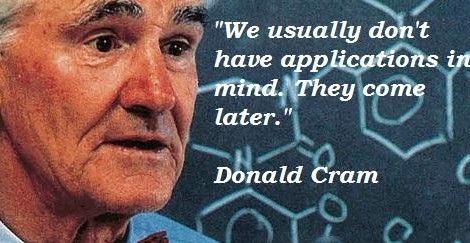
Cram -ing for cold fusion
Out of the box cold fusion has attracted more than a few Nobel Laureates.
The late Donald Cram is one that few know had an active interest in the field.
Cram won the Nobel prize in chemistry in 1987 for his work on ‘crown ethers’ and other host-guest molecules. He expanded upon Charles Pedersen’s ground-breaking synthesis of crown ethers, two-dimensional organic compounds that are able to recognize and selectively combine with the ions of certain metal elements and in the proton pump character of such species.
Cram’s “hobby” was out of the box thinking and as a result the revolutionizing of organic chemistry. Upon his death from cancer in 2001 at age 82, Cram had spent more than 50 years at UCLA pursuing that hobby, with an intensity that only increased with every passing year. He synthesized molecules that took this chemistry into three dimensions, creating an array of differently shaped molecules that could interact selectively with other chemicals because of their complementary three-dimensional structures.
I first heard of Cram’s interest in cold fusion from my friend Tom Passell who was at the time running the cold fusion research program of the Electric Power Research Institute. Tom was frequently approached by people with cold fusion ideas and an interest in being funded by EPRI. It seems Prof. Cram and his partner and former student Kenneth Dewhirst had visited Tom at EPRI with the claim that they had unraveled a vital secret regarding cold fusion and were seeking funding.
Apparently they, in spite of being rather mercurial about the details, proposed that if EPRI would provide prodigious funding they were willing to get to work on R&D. Tom was neither so flush with EPRI funds nor so likely to bet even on a Nobel laureate without more information. The result is Cram and Dewhirst left empty-handed. I was usually up for doing some work to try to figure out what ‘new blood’ had in this field so I am sure that is why Tom shared the Cram meeting details with me.
I, of course, contacted Prof. Cram at UCLA and did my best to see what I could find out. He was polite but not very forthcoming but after some study on his fields of interest and the unusual characteristics supra-molecular chemistry, molecules within molecules, it seemed clear he was on the trail of host-guest deuterated chemistry and catalyst design that might produce cold fusion on a molecular scale.
In retrospect, this is a pretty good guess as we now know rather well that cold fusion likes catalyst and nano-environments and you don’t get much more nano than being at a molecular level. Given that Crams life work was with proton (deuteron) pumping molecules hosting trapped transition metals it’s not a stretch at all to imagine he was on the trail of a supra-molecular cold fusion atom-ecology.
We may never know what cold fusion trail Prof. Cram however unless he wrote up his cold fusion ideas in his notes and journals. Now that he has passed I hope someone finds the inspiration and time to go searching for organic cold fusion chemistry. It’s likely a worthwhile trail to follow. Prof. Cram’s works and papers are housed in a dusty archive at UCLA.

